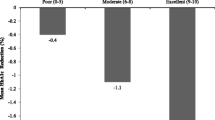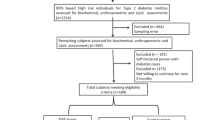Abstract
This study was designed to evaluate the effect of yogasanas on glycaemic control, haemodynamic and lipid profile in newly diagnosed subjects with type 2 diabetes prescribed with oral hypoglycaemic agents (OHA). Three hundred and three (M:F 199:104) subjects were recruited in this prospective study and were divided into two groups. Group 1 (N = 149) were prescribed OHA alone, while group 2 subjects (N = 154) were prescribed OHA and received training individually once for regular yoga practice for 30 min daily. Baseline data on anthropometric, haemodynamic and biochemical details were collected, and subjects were asked to report for review after 3 months. All investigations were repeated after 3 months. A total of 241 subjects were available for follow-up. Diabetes treatment regimen was unchanged in both the groups during the study period. Both the groups were matched with respect to body mass index (BMI), glycaemic level, lipid profile and diet calorie consumption at baseline. BMI did not differ significantly at follow-up in both the groups. Glucose levels and HbA1c % showed greater reduction in group 2 practising yoga. Total and low-density lipoprotein (LDL) cholesterol alone improved in group 1, whereas improvement was seen in all lipid parameters in group 2. High-density lipoprotein (HDL) cholesterol was not statistically significant in both groups. Group 1 showed improvement in systolic blood pressure (P = 0.027), whereas group 2 subjects showed improvement in both systolic and diastolic blood pressures (P < 0.0001). In conclusion, regular practice of yoga along with conventional medicines could be beneficial for better control of diabetes.

Similar content being viewed by others
References
Wild S, Roglic G, Green A, Sicree R, King H. Global prevalence of diabetes: estimates for the year 2000 and projections for 2030. Diabetes Care. 2004;27:1047–53.
Mohan V, Sandeep S, Deepa R, Shah B, Varghese C. Epidemiology of type 2 diabetes: Indian scenario. Indian J Med Res. 2007;125:217–30.
Kahn CR. New concepts in the pathogenesis of diabetes mellitus. Adv Intern Med. 1996;41:285–321.
George P, Ludvik B. Lipids and diabetes. J Clin Basic Cardiol. 2000;3:159–62.
Grundy SM, Pasternak R, Greenland P, Smith S, Fuster V. Assessment of cardiovascular risk by use of multiple-risk-factor assessment equations: a statement for health care professionals from the American Heart Association and the American College of Cardiology. Circulation. 1999;100:1481–92.
Yang K. A review of yoga programs for four leading risk factors of chronic diseases. Evid Based Complement Alternat Med. 2007;4:487–91.
Guarracino JL, Savino S, Edelstein S. Yoga participation is beneficial to obesity prevention, hypertension control, and positive quality of life. Top Clin Nutr. 2006;21:108–13.
Stevens DL. The use of complementary and alternative therapies in diabetes. Clin Fam Pract. 2002;4:911–28.
Sahay BK. Role of yoga in diabetes. J Assoc Physicians India. 2007;55:121–26.
Singh S, Malhotra V, Singh KP, Madhu SV, Tandon OP. Role of yoga in modifying certain cardiovascular functions in type 2 diabetic patients. J Assoc Physicians India. 2004;52:203–6.
Jyotsna VP, Joshi A, Ambekar S, Kumar N, Dhawan A, Sreenivas V. Comprehensive yogic breathing program improves quality of life in patients with diabetes. Indian J Endocrinol Metab. 2012;16(3):423–8.
Manyam BV. Diabetes mellitus, ayurveda and yoga. J Altern Complement Med. 2004;10:223–5.
Lazar SW, Bush G, Gollub RL, Fricchione GL, Khalsa G, Benson H. Functional brain mapping of the relaxation response and meditation. Neuroreport. 2000;11(7):1581–5.
Viswanathan V, Chacko PT, Lavanya M, Priyanka T. A proof of concept, preliminary study to determine the effect of yogasanas in controlling type 2 diabetes mellitus in newly detected subjects (when compared to metformin monotherapy). J Assoc Physicians India. 2006;54:965–6.
World Health Organization. Definition, diagnosis and classification of diabetes mellitus and its complications. Report of a WHO consultation. Part I: diagnosis and classification of diabetes mellitus. Geneva: World Health Organization; 1999.
Gore MM. Yogic treatment for diabetes. Yoga Mimamsa. 1988;26:130–45.
Malhotra V, Singh S, Tandon OP, Sharma SB. The beneficial effect of yoga in diabetes. Nepal Med Coll J. 2005;7(2):145–7.
Savita S, Tenzin K, Singh KP, Tandon OP, Madhu SV. Influence of pranayamas and yoga-asanas on serum insulin, blood glucose and lipid profile in type 2 diabetes. Indian J Clin Biochem. 2008;23:365–8.
Agrawal RP, Aradhana R, Hussain S, Beniwal R, Sabir M, Kochar DK, et al. Influence of yogic treatment on quality of life outcomes, glycaemic control and risk factors in diabetes mellitus. Int J Diabetes Dev Ctries. 2003;23:130–4.
Delmonte MM. Biochemical indices associated with meditation practice. A literature review. Neurosci Biobehav Rev. 1985;9:557–61.
Amita S, Prabhakar S, Manoj I, Harminder S, Pavan T. Effect of yoga-nidra on blood glucose level in diabetic patients. Indian J Physiol Pharmacol. 2009;53(1):97–101.
Hegde SV, Adhikari P, Kotian S, Pinto VJ, D’Souza S, D’Souza V. Effect of 3-month yoga on oxidative stress in type 2 diabetes with or without complications: a controlled clinical trial. Diabetes Care. 2011;34:2208–10.
Monroe R, Power J, Comer A, Nagarathna R, Dandona P. Yoga therapy for NIDDM: a controlled trial. Complement Med Res. 1992;6:66–8.
Elder C, Aickin M, Bauer V, Cairns J, Vuckovic N. Randomized trial of a whole-system ayurvedic protocol for type 2 diabetes. Altern Ther Health Med. 2006;12:24–30.
Malhotra V, Singh S, Singh KP, Madhu SV, Tandon OP. Study of yoga asanas in assessment of pulmonary function in NIDDM patients. Indian J Physiol Pharmacol. 2002;46:313–20.
Jablon SL, Naliboff BD, Gilmore SL, Rosenthal MJ. Effects of relaxation training on glucose tolerance and diabetic control in type II diabetes. Appl Psychophysiol Biofeedback. 1997;22:155–69.
Harinath K, Malhotra AS, Pal K, Prasad R, Kumar R, Kain TC, et al. Effects of hatha yoga and omkar meditation on cardiorespiratory performance, psychologic profile and melatonin secretion. J Altern Complement Med. 2004;10:261–68.
Aljasir B, Bryson M, Al-shehri B. Yoga practice for the management of type II diabetes mellitus in adults: a systematic review. Evid Based Complement Alternat Med. 2008;1–10 doi: 10.1093/ecam/neno27.
Acknowledgments
We would like to thank all the participants who extended full co-operation throughout the study period. We also thank Ms. Evangelene Stafford for her help in data collection. The help rendered by Mr. Saravanamurthy in the preparation of the manuscript is also gratefully acknowledged.
Conflict of interest
None declared
Author information
Authors and Affiliations
Corresponding author
Rights and permissions
About this article
Cite this article
Kumpatla, S., Michael, C. & Viswanathan, V. Effect of yogasanas on glycaemic, haemodynamic and lipid profile in newly diagnosed subjects with type 2 diabetes. Int J Diabetes Dev Ctries 35 (Suppl 2), 181–188 (2015). https://doi.org/10.1007/s13410-014-0255-2
Received:
Accepted:
Published:
Issue Date:
DOI: https://doi.org/10.1007/s13410-014-0255-2




